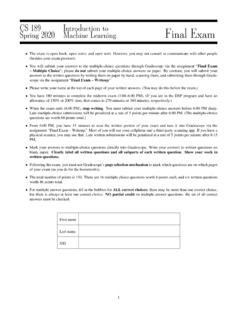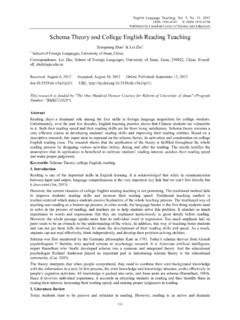Transcription of Stacked Convolutional Auto-Encoders for Hierarchical ...
1 Stacked Convolutional Auto-Encoders forHierarchical feature ExtractionJonathan Masci, Ueli Meier, Dan Cire san, and J urgen SchmidhuberIstituto Dalle Molle di Studi sull Intelligenza Artificiale (IDSIA)Lugano, present a novel Convolutional auto-encoder (CAE) forunsupervised feature learning . A stack of CAEs forms a convolutionalneural network (CNN). Each CAE is trained using conventional on-linegradient descent without additional regularization terms. A max-poolinglayer is essential to learn biologically plausible features consistent withthose found by previous approaches. Initializing a CNN with filters of atrained CAE stack yields superior performance on a digit (MNIST) andan object recognition (CIFAR10) : Convolutional neural network, auto-encoder, unsupervisedlearning, IntroductionThe main purpose of unsupervised learning methods is to extract generally use-ful features from unlabelled data, to detect and remove input redundancies, andto preserve only essential aspects of the data in robust and discriminative rep-resentations.
2 Unsupervised methods have been routinely used in many scientificand industrial applications. In the context of neural network architectures, un-supervised layers can be Stacked on top of each other to build deep hierarchies[7]. Input layer activations are fed to the first layer which feeds the next, andso on, for all layers in the architectures can be trained in anunsupervised layer-wise fashion, and later fine-tuned by back-propagation to be-come classifiers [9]. Unsupervised initializations tend to avoid local minima andincrease the network s performance stability [6].Most methods are based on theencoder-decoderparadigm, , [20]. The in-put is first transformed into a typically lower-dimensional space(encoder),andthen expanded to reproduce the initial data(decoder). Once a layer is trained,its code is fed to the next, to better model highly non-linear dependencies in theinput. Methods using this paradigm include stacks of: Low-Complexity Codingand Decoding machines (LOCOCODE) [10], Predictability Minimization lay-ers [23,24], Restricted Boltzmann Machines (RBMs) [8], Auto-Encoders [20] andenergy based models [15].
3 In visual object recognition, CNNs [1,3,4,14,26] often excel. Unlike patch-based methods [19] they preserve the input s neighborhood relations andT. Honkela et al. (Eds.): ICANN 2011, Part I, LNCS 6791, pp. 52 59, Springer-Verlag Berlin Heidelberg 2011 Stacked Convolutional Auto-Encoders for Hierarchical feature Extraction53spatial locality in their latent higher-level feature representations. While thecommon fully connected deeparchitectures do not scalewell to realistic-sizedhigh-dimensional images in terms of computational complexity, CNNs do, sincethe number of free parameters describing their shared weights does not dependon the input dimensionality [16,18,28].This paper introduces theConvolutional Auto-Encoder, a Hierarchical unsu-pervised feature extractor that scales well to high-dimensional inputs. It learnsnon-trivial features using plain stochastic gradient descent, and discovers goodCNNs initializations that avoid the numerous distinct local minima of highlynon-convex objective functions arising in virtually all deep learning Auto-EncoderWe recall the basic principles of auto-encoder models, , [2].
4 An auto-encodertakes an inputx Rdand first maps it to the latent representationh Rd usinga deterministic function of the typeh=f = (Wx+b) with parameters ={W, b}. This code is then used to reconstruct the input by a reverse mappingoff:y=f (h)= (W h+b )with ={W ,b }. The two parameter setsare usually constrained to be of the formW =WT, using the same weights forencoding the input and decoding the latent representation. Each training patternxiis then mapped onto its codehiand its reconstructionyi. The parametersare optimized, minimizing an appropriate cost function over the training setDn={(x0,t0), ..,(xn,tn)}. Denoising Auto-EncoderWithout any additional constraints, conventional Auto-Encoders learn the iden-tity mapping. This problem can be circumvented by using a probabilistic RBMapproach, or sparse coding, ordenoising Auto-Encoders (DAs) trying to recon-struct noisy inputs [27]. The latter performs as well as or even better thanRBMs [2].
5 Training involves the reconstruction of a clean input from a partiallydestroyed one. Inputxbecomes corrupted input xby adding a variable amountvof noise distributed according to the characteristics of the input image. Commonchoices include binomial noise (switching pixels on or off) for black and white im-ages, or uncorrelated Gaussian noise for color images. The parametervrepresentsthe percentage of permissible corruption. The auto-encoder is trained todenoisethe inputs by first finding the latent representationh=f ( x)= (W x+b)fromwhich to reconstruct the original inputy=f (h)= (W h+b ). Convolutional Neural NetworksCNNs are Hierarchical models whose Convolutional layers alternate with sub-sampling layers, reminiscent of simple and complex cells in the primary visualcortex [11]. The network architecture consists of three basic building blocks54J. Masci et be Stacked and composed as needed. We have the Convolutional layer, themax-pooling layer and the classification layer [14].
6 CNNs are among the mostsuccessful models for supervised image classification and set the state-of-the-artin many benchmarks [13,14].3 Convolutional Auto-Encoder (CAE)Fully connected AEs and DAEs both ignorethe 2D image structure. This is notonly a problem when dealing with realistically sized inputs, but also introducesredundancy in the parameters, forcing each feature to be global ( , to span theentire visual field). However, the trend in vision and object recognition adoptedby the most successful models [17,25] is to discover localized features that re-peat themselves all over the input. CAEs differs from conventional AEs as theirweights are shared among all locations in the input, preserving spatial reconstruction is hence due to a linear combination of basic image patchesbased on the latent CAE architecture is intuitively similar to the one described in Sec. ,except that the weights are shared. For a mono-channel inputxthe latent rep-resentation of the k-thfeature map is given byhk= (x Wk+bk)(1)where the bias is broadcasted to the whole map, is an activation function (weused the scaled hyperbolic tangent in all our experiments), and denotes the2D convolution.
7 A single bias per latent map is used, as we want each filter tospecialize on features of the whole input (one bias per pixel would introduce toomany degrees of freedom). The reconstruction is obtained usingy= ( k Hhk Wk+c)(2)where again there is one biascper input the group of latentfeature maps; Widentifies the flip operation over both dimensions of the 2D convolution in equation (1) and (2) is determined by context. The convo-lution of anm mmatrix with ann nmatrix may in fact result in an (m+n 1) (m+n 1) matrix (full convolution) or in an (m n+1) (m n+ 1) (validconvolution). The cost function to minimize is the mean squared error (MSE):E( )=12nn i=1(xi yi)2.(3)Just as for standard networks the backpropagation algorithm is applied to com-pute the gradient of the error function with respect to the parameters. This canbe easily obtained by convolution operations using the following formula: E( ) Wk=x hk+ hk y.(4) hand yare the deltas of the hidden states and the reconstruction, weights are then updated using stochastic gradient Convolutional Auto-Encoders for Hierarchical feature Max-PoolingFor Hierarchical networks in general and CNNs in particular, a max-pooling layer[22] is often introduced to obtain translation-invariant representations.
8 Max-pooling down-samples the latent representation by a constant factor, usuallytaking the maximum value over non overlapping sub-regions. This helps improv-ing filter selectivity, as the activation of each neuron in the latent representationis determined by the match between the feature and the input field over theregion of interest. Max-pooling was originally intended for fully-supervised feed-forward architectures we introduce a max-pooling layer that introduces sparsity over the hid-den representation by erasing all non-maximal values in non overlapping sub-regions. This forces the feature detectors to become more broadly applicable,avoiding trivial solutions such as having only one weight on (identity func-tion). During the reconstruction phase, such a sparse latent code decreases theaverage number of filters contributing to the decoding of each pixel, forcing filtersto be more general. Consequently, with a max-pooling layer there is no obviousneed for L1 and/or L2 regularization over hidden units and/or Stacked Convolutional Auto-Encoders (CAES)Several AEs can be Stacked to form a deep hierarchy, [27].
9 Each layer receivesits input from the latent representation of the layer below. As for deep beliefnetworks, unsupervised pre-training can be done in greedy, layer-wise the weights can be fine-tuned using back-propagation, or the toplevel activations can be used as feature vectors for SVMs or other , a CAE stack (CAES) can be used to initialize a CNN with identicaltopology prior to a supervised training ExperimentsWe begin by visually inspecting the filters of various CAEs, trained in varioussetups on a digit dataset (MNIST [14]) and on natural images (CIFAR10 [13]).In Figure 1 we compare 20 7 7 filters (learned on MNIST) of four CAEs ofthe same topology, but trained differently. The first is trained on original digits(a), the second on noisy inputs with 50% binomial noise added (b), the thirdhas an additional max-pooling layer of size 2 2 (c), and the fourth is trainedon noisy inputs (30% binomial noise) and has a max-pooling layer of size 2 2(d).
10 We add 30% noise in conjunction with max-pooling layers, to avoid loss oftoo much relevant information. The CAE without any additional constraints (a)learns trivial solutions. Interesting and biologically plausible filters only emergeonce the CAE is trained with a max-pooling layer. With additional noise thefilters become more localized. For this particular example, max-pooling yieldsthe visually nicest filters; those of the other approaches do not have a well-definedshape. A max-pooling layer is an elegant way of enforcing a sparse code requiredto deal with the overcomplete representations of Convolutional Masci et al.(a)(b)(c)(d)Fig. randomly selected subset of the first layer s filters learned on MNIST tocompare noise and pooling. (a) No max-pooling, 0% noise, (b) No max-pooling, 50%noise, (c) Max-pooling of 2x2, (d) Max-pooling of 2x2, 30% noise.(a)(b)(c)(d)Fig. randomly selected subset of the first layer s filters learned on CIFAR10 tocompare noise and pooling (best viewed in colours).








